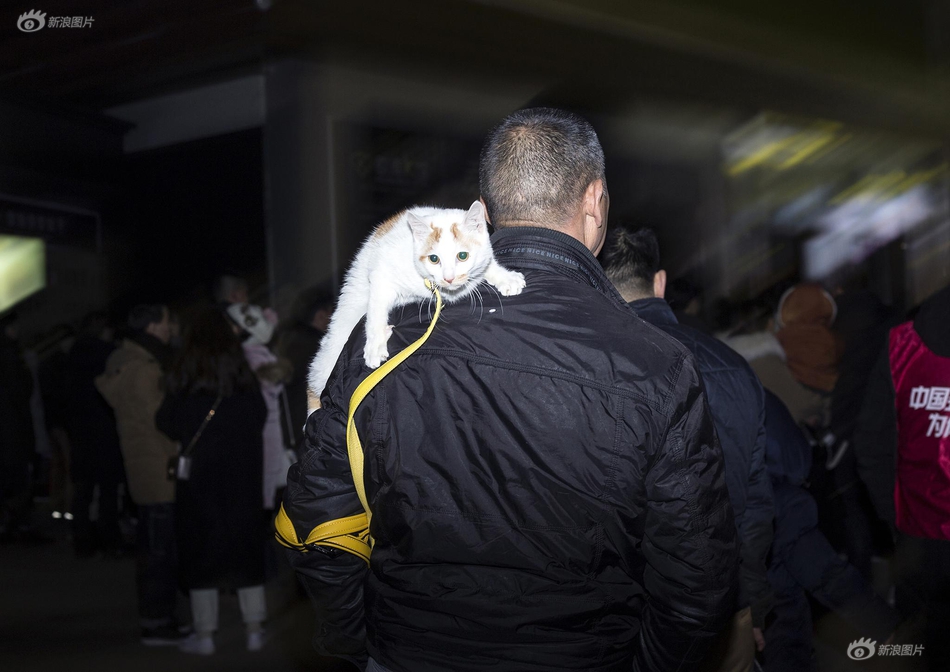This November, Pig the dugong celebrated his 21st birthday at SEA LIFE Sydney Aquarium. The birthday boy was presented with a bean sprout cake and new toy at a party thrown in his honor, complete with conical hats and party games.
Sadly, Pig couldn’t blow out any birthday candles, because he is a dugong. However, his carers did pass on a birthday wish: for humans to help conserve his native habitat and save his species.
The IUCN Red List categorizes dugongs as vulnerable, with a population on the decline. According to SEA LIFE Sydney Aquarium’s dugong supervisor Kerrie McDonald, conservation campaigns are hampered by the simple fact that many people don’t know what dugongs are.
“A lot of people get confused and maybe think that [Pig’s] a manatee, or even I’ve heard walrus or dolphin or whale,” McDonald told Mashable.

It turns out the memelied, and dugongs and manatees are in fact different animals. Though they are in the same order, there are four living species of manatee and only one species of dugong. Both have a similar body shape, but dugongs are much smaller than manatees.
“They move a little bit differently,” said McDonald. “The flippers on the manatees are quite mobile, they spin right around — they’re like little propellers. They’re quite cute.”
Dugongs have a longer lifespan at 60 to 70 years, and reproduce more slowly, giving birth to a single calf at three to seven year intervals. They are also marine animals, whereas manatees will enjoy rivers and brackish water, and eat a wider variety of foods.
Unfortunately, this is an area where manatees have an advantage over dugongs, as their strict dietary requirements are becoming more difficult to meet.
 SEA LIFE Sydney Aquarium staff offer Pig his bean sprout and jelly birthday cake during his birthday party on Nov. 27, 2019.Credit: Don Arnold / WireImage
SEA LIFE Sydney Aquarium staff offer Pig his bean sprout and jelly birthday cake during his birthday party on Nov. 27, 2019.Credit: Don Arnold / WireImageA wild dugong’s diet is comprised almost exclusively of seagrass, which grows in the shallow, relatively gentle water of sheltered bays and estuaries. Unfortunately, humans also enjoy these areas, putting grazing dugongs in danger of boat strikes and shark net entanglements.
Seagrass can also be disturbed by human activity, torn up by dropped anchors. This is foliage we can’t afford to use, as the greatest threat these marine mammals face is lack of food.
“If there’s a big storm and it creates lots of runoff, you’ve got all of these chemicals and pollution going into the ocean,” said McDonald. “It can affect the seagrass quality.” Sediment suspended in the water and algal bloomscaused by nutrient pollution can block sunlight from reaching the seagrass, killing entire meadows.
Seagrass is also threatened by climate change, with increasing ocean temperatures making the environment inhospitableto the plants. A heatwave in the summer of 2010-11 destroyed a significant amount of seagrass in UNESCO World Heritage Site Shark Bay, Western Australia. Home to 10 percent of the global dugong population, Shark Bay’s seagrass was reduced by 22 percentbetween 2002 and 2014.
"Seagrass is an organism that grows very slowly and it takes ages to recover, so this can't happen in a couple of years,” Dr. Oscar Serrano told the Australian Broadcasting Corporation. “It will take decades."
Now in the summer of 2019-20, Australia is going through an unprecedented heatwave, with the hottest days since records began. While the land is devastated by uncontrollable bushfires, the ocean is similarlyravagedby heat, killing marine life and releasing tons of carbon dioxide into the atmosphere.
 Pig lives in SEA LIFE Sydney Aquarium because he is a big soft boy who can't fend for himself in the wild.Credit: Don Arnold / WireImage
Pig lives in SEA LIFE Sydney Aquarium because he is a big soft boy who can't fend for himself in the wild.Credit: Don Arnold / WireImageGrowing enough seagrassin an aquarium to feed a hungry dugong is difficult. Instead, SEA LIFE Sydney Aquarium’s resident sea cow eats cos lettuce, threaded through weighted racks so it stands straight up at the bottom of his tank.
Pig was less than one week old when he was found washed up on Queensland’s Forrest Beach in 1998. Too young to fend for himself, he lived under human care for three years before being released back into the wild. Pig was taken into permanent human care eight months later, after he was found having lost a quarter of his body weight and bearing injuries presumably from other male dugongs.
SEE ALSO:Researchers are using drones and AI to count dugongs in the oceanAfter Wuru died in May 2018, Pig became the only dugong in human care in Australia. However, McDonald assured Mashable that Pig isn’t lonely.
“They’re actually solitary animals,” said McDonald. “A lot of people think because they’re seen in herds in the wild — or what look like herds — they interact a lot. But from the researchers I’ve talked to generally the only reason they’re all together is the food source is there. So they’re all hanging out eating, but they’re not actually interacting with each other as they’re doing the eating.”
Dugongs — they’re just like us.
Even so, Pig’s unconventional upbringing means he also loves human attention. “Any attention he can get from his keepers, and he even solicits it from members of the public as well,” said McDonald. “He’s obviously got lots of fish, shark, and rays in the tank as well, but definitely more focused on people or his lettuce or his toys.”
 The birthday boy on his big day.Credit: Don Arnold / WireImage
The birthday boy on his big day.Credit: Don Arnold / WireImageThough Pig’s future is safe, not every dugong has a team of dedicated staff ensuring they never go hungry. Therefore, to raise awareness for dugong conservation as well as celebrate Pig’s 21st year, SEA LIFE Sydney Aquarium is petitioning for a dugong emoji to be added to our lexicons.
The petition started in late October hasn’t quite gathered the signatures they were hoping for, but the aquarium intends to keep it open until it has.
“People might share a photo if they’re visiting [Pig] here and put the emoji up, or even if they saw one in the wild and use it, and just gets people thinking, ‘What is that?’” said McDonald. The hope is that it will spark interest in these vulnerable animals, stoking conservation efforts. Ideally, this would lead to a flow on effect benefiting all marine life.
“Hopefully, holistically, if people want to protect the dugong they want to protect the environment which helps so many animals as well,” said McDonald. “If you just keep the oceans clean it helps everything.”
On top of signing the petition and being mindful of their own pollution, McDonald said people can help by donating to the aquarium’s SEA LIFE Trust, which works to conserve and protect marine habitats and wildlife. They can also visit Pig at SEA LIFE Sydney Aquarium, and “just [share] the message of what a dugong is.”
However, to ensure a future for dugongs, seagrass, and all marine life, it's most essential that we fight climate change.
TopicsAnimalsSustainability



 相关文章
相关文章



 精彩导读
精彩导读



 热门资讯
热门资讯 关注我们
关注我们
